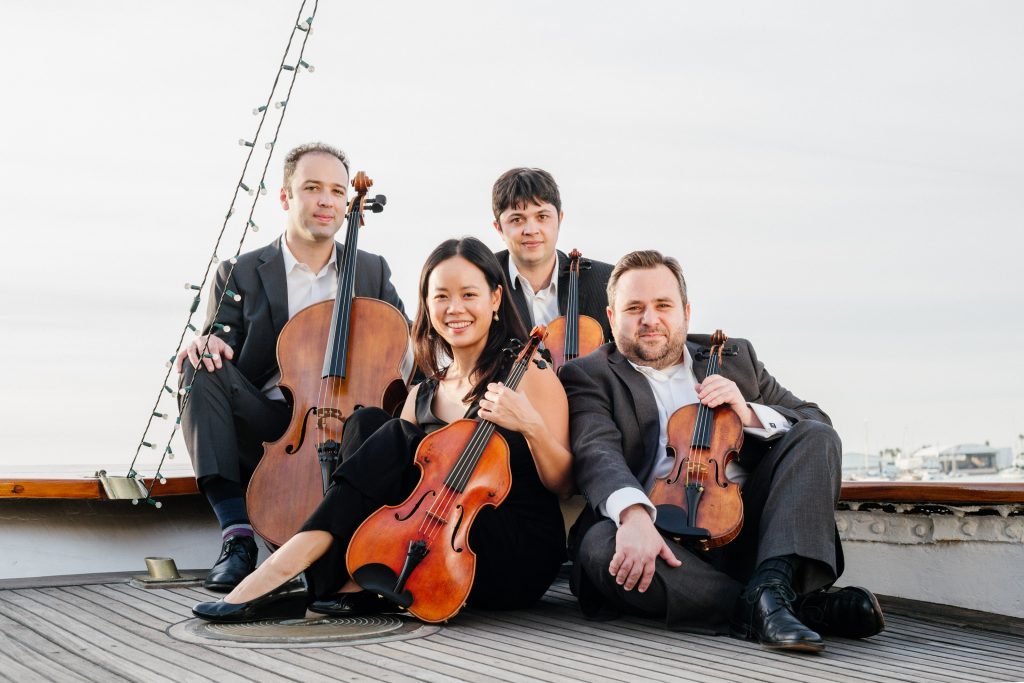Progress: Hausmann Quartet Returns to Perform Indoors With an Audience
The Hausmann Quartet’s Haydn Voyages series has returned to its customary indoor performance venue at the Maritime Museum of San Diego—with the audience present. During the earlier stages of the pandemic shutdown, the ensemble streamed online concerts from the Maritime Museum, and they played their last concert in May outside at the museum to a small audience. Although both the performers and audience members remained masked at Sunday afternoon’s concert, this return to the usual format proved most welcome.

Hausmann Quartet: (from left) Alex Greenbaum, Angela Choong, Isaac Allen, Bram Goldstein [photo (c.) Samantha Zauscher]
Hausmann chose a vivacious Allegro assai by Joseph Boulogne, Chevalier de St. Georges, for their quartet’s opening movement. Displaying that easy-going, harmonically uncomplicated style we call galant, the well-structured movement provided ample solo lines for the cello and viola, not just the first violin, as much of this repertory tends to do. First violinist Isaac Allen did all of the heavy lifting in Johan Baptist Vanhal’s Adagio, however, spinning out polished, deftly detailed variations of the elegant theme that opens the movement. Carl Ditters von Dittersdorf’s Menuet sounded like a pair of mismatched minuets: first a highly ornamented slow dance followed by a stirring minuet in double time.
Wisely choosing Mozart’s Molto allegro (K. 387) to complete this unusual string quartet, the composer’s spirited fugal opening and his playfully unpredictable themes provided a depth not probed by the other composers. This is, of course, only one of the reasons Mozart is a household name and Johann Vanhal et.al. are not. But the pastiche made for a charming diversion.
Yangfan Xu’s 2019 “A Bit Blue,” an episodic single movement work, suggested a tableau of jazzy syncopations and riffs, contrasted with pizzicato pentatonic themes, probably not an unexpected combination from a Chinese-American composer, a protege of Mason Bates.
Hausmann’s engaging account of two movements from Korean-American composer Juri Seo’s “Infinite Season” (2017-2018) revealed her different approach from the familiar Vivaldi concertos based on seasonal themes: Seo attempts to suggest the changes between seasons, rather than the character of the season itself. So “Winter-Spring” opens with soft, sustained close intervals and deft harmonics that eventually break into short, tentative themes that become more active, ascending arcs. “Summer-Fall,” a brisk, unexpectedly terse movement, explodes with busy, grinding themes contrasted with unrelenting arpeggios.
For those who are keeping score, with the performance of Haydn’s “Dream” Quartet, Hausmann has made it to the half-way mark as they work through his entire cannot 69 string quartets. In the opening Allegro moderato, Allen’s supple, stylish lead benefited from cellist Alex Greenbaum’s assertive, pulsing bass lines as well as the taut ensemble playing of the entire quartet. The Poco adagio’s reverent, almost hymn-like radiance, convinced the audience that “Dream” was a worthy description of the composer’s suave, ingratiating themes. Haydn’s ebullient finales never disappoint, and neither does Hausmann’s sparkling, convivial ensemble. Violinist Bram Goldstein and violist Angela Choong are the other Hausmann members.
This program was presented by the Hausmann Quartet on Sunday, September 12, 2021, on the Maritime Museum of San Diego’s Berkeley on San Diego Bay.

Ken Herman, a classically trained pianist and organist, has covered music for the San Diego Union, the Los Angeles Times’ San Diego Edition, and for sandiego.com. He has won numerous awards, including first place for Live Performance and Opera Reviews in the 2017, the 2018, and the 2019 Excellence in Journalism Awards competition held by the San Diego Press Club. A Chicago native, he came to San Diego to pursue a graduate degree and stayed.Read more…
